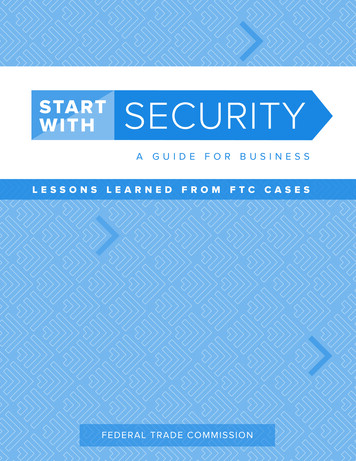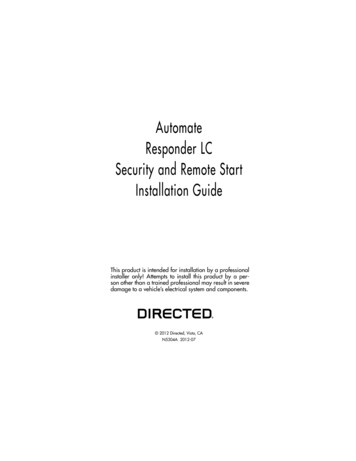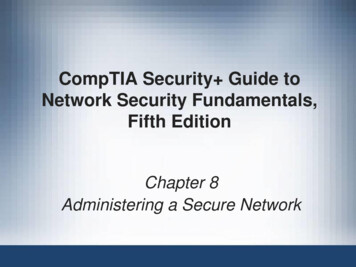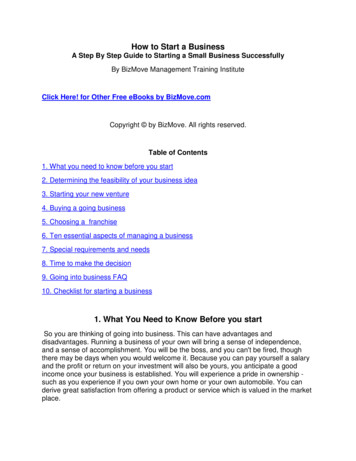
Transcription
STA RTWITHA GUIDE FOR BUSINESSLESSONS LEARNED FROM FTC CASESFED ERA L T RAD E C OMMIS S ION
STA RTWITH1.Start with security.2. Control access to data sensibly.3. Require secure passwords and authentication.4. Store sensitive personal information securely and protect itduring transmission.5. Segment your network and monitor who’s trying to get in andout.6. Secure remote access to your network.7.Apply sound security practices when developing new products.8. Make sure your service providers implement reasonable securitymeasures.9. Put procedures in place to keep your security current andaddress vulnerabilities that may arise.10. Secure paper, physical media, and devices.
When managing your network, developing an app, or even organizing paperfiles, sound security is no accident. Companies that consider security from thestart assess their options and make reasonable choices based on the natureof their business and the sensitivity of the information involved. Threats todata may transform over time, but the fundamentals of sound security remainconstant. As the Federal Trade Commission outlined in Protecting PersonalInformation: A Guide for Business, you should know what personal informationyou have in your files and on your computers, and keep only what you needfor your business. You should protect the information that you keep, andproperly dispose of what you no longer need. And, of course, you shouldcreate a plan to respond to security incidents.In addition to Protecting Personal Information, the FTC has resources to helpyou think through how those principles apply to your business. There’s anonline tutorial to help train your employees; publications to address particulardata security challenges; and news releases, blog posts, and guidance to helpyou identify – and possibly prevent – pitfalls.There’s another source of information about keeping sensitive data secure:the lessons learned from the more than 50 law enforcement actions the FTChas announced so far. These are settlements – no findings have been madeby a court – and the specifics of the orders apply just to those companies,of course. But learning about alleged lapses that led to law enforcement canhelp your company improve its practices. And most of these alleged practicesinvolve basic, fundamental security missteps. Distilling the facts of thosecases down to their essence, here are ten lessons to learn that touch onvulnerabilities that could affect your company, along with practical guidance onhow to reduce the risks they pose.1
1Start with security.From personal data on employment applications to network files with customers’ creditcard numbers, sensitive information pervades every part of many companies. Businessexecutives often ask how to manage confidential information. Experts agree on the keyfirst step: Start with security. Factor it into the decisionmaking in every department ofyour business – personnel, sales, accounting, information technology, etc. Collecting andmaintaining information “just because” is no longer a sound business strategy. Savvycompanies think through the implication of their data decisions. By making consciouschoices about the kind of information you collect, how long you keep it, and who canaccess it, you can reduce the risk of a data compromise down the road. Of course, allof those decisions will depend on the nature of your business. Lessons from FTC casesillustrate the benefits of building security in from the start by going lean and mean in yourdata collection, retention, and use policies.Don’t collect personal information you don’t need.Here’s a foundational principle to inform your initial decision-making: No one can stealwhat you don’t have. When does your company ask people for sensitive information?Perhaps when they’re registering online or setting up a new account. When was the lasttime you looked at that process to make sure you really need everything you ask for?That’s the lesson to learn from a number of FTC cases. For example, the FTC’s complaintagainst RockYou charged that the company collected lots of information during thesite registration process, including the user’s email address and email password. Bycollecting email passwords – not something the business needed – and then storingthem in clear text, the FTC said the company created an unnecessary risk to people’semail accounts. The business could have avoided that risk simply by not collectingsensitive information in the first place.Hold on to information only as long as you have a legitimatebusiness need.Sometimes it’s necessary to collect personal data as part of a transaction. But once thedeal is done, it may be unwise to keep it. In the FTC’s BJ’s Wholesale Club case, thecompany collected customers’ credit and debit card information to process transactionsin its retail stores. But according to the complaint, it continued to store that data forup to 30 days – long after the sale was complete. Not only did that violate bank rules,but by holding on to the information without a legitimate business need, the FTC saidBJ’s Wholesale Club created an unreasonable risk. By exploiting other weaknesses inthe company’s security practices, hackers stole the account data and used it to makecounterfeit credit and debit cards. The business could have limited its risk by securelydisposing of the financial information once it no longer had a legitimate need for it.2
Don’t use personal information when it’s not necessary.You wouldn’t juggle with a Ming vase. Nor should businesses use personal informationin contexts that create unnecessary risks. In the Accretive case, the FTC alleged that thecompany used real people’s personal information in employee training sessions, andthen failed to remove the information from employees’ computers after the sessions wereover. Similarly, in foru International, the FTC charged that the company gave access tosensitive consumer data to service providers who were developing applications for thecompany. In both cases, the risk could have been avoided by using fictitious informationfor training or development purposes.2Control access to data sensibly.Once you’ve decided you have a legitimate business need to hold on to sensitive data,take reasonable steps to keep it secure. You’ll want to keep it from the prying eyes ofoutsiders, of course, but what about your own employees? Not everyone on your staffneeds unrestricted access to your network and the information stored on it. Put controlsin place to make sure employees have access only on a “need to know” basis. For yournetwork, consider steps such as separate user accounts to limit access to the placeswhere personal data is stored or to control who can use particular databases. For paperfiles, external drives, disks, etc., an access control could be as simple as a locked filecabinet. When thinking about how to control access to sensitive information in yourpossession, consider these lessons from FTC cases.Restrict access to sensitive data.If employees don’t have to use personal information as part of their job, there’s no needfor them to have access to it. For example, in Goal Financial, the FTC alleged that thecompany failed to restrict employee access to personal information stored in paperfiles and on its network. As a result, a group of employees transferred more than 7,000consumer files containing sensitive information to third parties without authorization.The company could have prevented that misstep by implementing proper controls andensuring that only authorized employees with a business need had access to people’spersonal information.3
Limit administrative access.Administrative access, which allows a user to make system-wide changes to your system,should be limited to the employees tasked to do that job. In its action against Twitter,for example, the FTC alleged that the company granted almost all of its employeesadministrative control over Twitter’s system, including the ability to reset user accountpasswords, view users’ nonpublic tweets, and send tweets on users’ behalf. Accordingto the complaint, by providing administrative access to just about everybody in-house,Twitter increased the risk that a compromise of any of its employees’ credentials couldresult in a serious breach. How could the company have reduced that risk? By ensuringthat employees’ access to the system’s administrative controls was tailored to their jobneeds.3Require secure passwords andauthentication.If you have personal information stored on your network, strong authenticationprocedures – including sensible password “hygiene” – can help ensure that onlyauthorized individuals can access the data. When developing your company’s policies,here are tips to take from FTC cases.Insist on complex and unique passwords.“Passwords” like 121212 or qwerty aren’t much better than no passwords at all. That’swhy it’s wise to give some thought to the password standards you implement. In theTwitter case, for example, the company let employees use common dictionary wordsas administrative passwords, as well as passwords they were already using for otheraccounts. According to the FTC, those lax practices left Twitter’s system vulnerableto hackers who used password-guessing tools, or tried passwords stolen from otherservices in the hope that Twitter employees used the same password to access thecompany’s system. Twitter could have limited those risks by implementing a more securepassword system – for example, by requiring employees to choose complex passwordsand training them not to use the same or similar passwords for both business andpersonal accounts.4
Store passwords securely.Don’t make it easy for interlopers to access passwords. In Guidance Software, theFTC alleged that the company stored network user credentials in clear, readable textthat helped a hacker access customer credit card information on the network. Similarly,in Reed Elsevier, the FTC charged that the business allowed customers to store usercredentials in a vulnerable format in cookies on their computers. In Twitter, too, the FTCsaid the company failed to establish policies that prohibited employees from storingadministrative passwords in plain text in personal email accounts. In each of those cases,the risks could have been reduced if the companies had policies and procedures in placeto store credentials securely. Businesses also may want to consider other protections– two-factor authentication, for example – that can help protect against passwordcompromises.Guard against brute force attacks.Remember that adage about an infinite number of monkeys at an infinite number oftypewriters? Hackers use automated programs that perform a similar function. Thesebrute force attacks work by typing endless combinations of characters until hackers luckinto someone’s password. In the Lookout Services, Twitter, and Reed Elsevier cases, theFTC alleged that the businesses didn’t suspend or disable user credentials after a certainnumber of unsuccessful login attempts. By not adequately restricting the number of tries,the companies placed their networks at risk. Implementing a policy to suspend or disableaccounts after repeated login attempts would have helped to eliminate that risk.Protect against authentication bypass.Locking the front door doesn’t offer much protection if the back door is left open. InLookout Services, the FTC charged that the company failed to adequately test itsweb application for widely-known security flaws, including one called “predictableresource location.” As a result, a hacker could easily predict patterns and manipulateURLs to bypass the web app’s authentication screen and gain unauthorized accessto the company’s databases. The company could have improved the security of itsauthentication mechanism by testing for common vulnerabilities.5
4Store sensitive personal informationsecurely and protect it during transmission.For many companies, storing sensitive data is a business necessity. And even if youtake appropriate steps to secure your network, sometimes you have to send that dataelsewhere. Use strong cryptography to secure confidential material during storageand transmission. The method will depend on the types of information your businesscollects, how you collect it, and how you process it. Given the nature of your business,some possibilities may include Transport Layer Security/Secure Sockets Layer (TLS/SSL)encryption, data-at-rest encryption, or an iterative cryptographic hash. But regardless ofthe method, it’s only as good as the personnel who implement it. Make sure the peopleyou designate to do that job understand how your company uses sensitive data and havethe know-how to determine what’s appropriate for each situation. With that in mind, hereare a few lessons from FTC cases to consider when securing sensitive information duringstorage and transmission.Keep sensitive information secure throughout its lifecycle.Data doesn’t stay in one place. That’s why it’s important to consider security at allstages, if transmitting information is a necessity for your business. In Superior MortgageCorporation, for example, the FTC alleged that the company used SSL encryption tosecure the transmission of sensitive personal information between the customer’s webbrowser and the business’s website server. But once the information reached the server,the company’s service provider decrypted it and emailed it in clear, readable text tothe company’s headquarters and branch offices. That risk could have been preventedby ensuring the data was secure throughout its lifecycle, and not just during the initialtransmission.Use industry-tested and accepted methods.When considering what technical standards to follow, keep in mind that experts alreadymay have developed effective standards that can apply to your business. Savvycompanies don’t start from scratch when it isn’t necessary. Instead, they take advantageof that collected wisdom. The ValueClick case illustrates that principle. Accordingto the FTC, the company stored sensitive customer information collected through itse-commerce sites in a database that used a non-standard, proprietary form of encryption.Unlike widely-accepted encryption algorithms that are extensively tested, the complaintcharged that ValueClick’s method used a simple alphabetic substitution system subject tosignificant vulnerabilities. The company could have avoided those weaknesses by usingtried-and-true industry-tested and accepted methods for securing data.6
Ensure proper configuration.Encryption – even strong methods – won’t protect your users if you don’t configureit properly. That’s one message businesses can take from the FTC’s actions againstFandango and Credit Karma. In those cases, the FTC alleged that the companiesused SSL encryption in their mobile apps, but turned off a critical process known asSSL certificate validation without implementing other compensating security measures.That made the apps vulnerable to man-in-the-middle attacks, which could allow hackersto decrypt sensitive information the apps transmitted. Those risks could have beenprevented if the companies’ implementations of SSL had been properly configured.5Segment your network and monitor who’strying to get in and out.When designing your network, consider using tools like firewalls to segment yournetwork, thereby limiting access between computers on your network and between yourcomputers and the internet. Another useful safeguard: intrusion detection and preventiontools to monitor your network for malicious activity. Here are some lessons from FTCcases to consider when designing your network.Segment your network.Not every computer in your system needs to be able to communicate with every otherone. You can help protect particularly sensitive data by housing it in a separate secureplace on your network. That’s a lesson from the DSW case. The FTC alleged that thecompany didn’t sufficiently limit computers from one in-store network from connectingto computers on other in-store and corporate networks. As a result, hackers could useone in-store network to connect to, and access personal information on, other in-storeand corporate networks. The company could have reduced that risk by sufficientlysegmenting its network.7
Monitor activity on your network.“Who’s that knocking on my door?” That’s what an effective intrusion detection tool askswhen it detects unauthorized activity on your network. In the Dave & Buster’s case,the FTC alleged that the company didn’t use an intrusion detection system and didn’tmonitor system logs for suspicious activity. The FTC says something similar happenedin Cardsystem Solutions. The business didn’t use sufficient measures to detectunauthorized access to its network. Hackers exploited weaknesses, installing programson the company’s network that collected stored sensitive data and sent it outside thenetwork every four days. In each of these cases, the businesses could have reducedthe risk of a data compromise or its breadth by using tools to monitor activity on theirnetworks.6Secure remote access to your network.Business doesn’t just happen in the office. While a mobile workforce can increaseproductivity, it also can pose new security challenges. If you give employees, clients,or service providers remote access to your network, have you taken steps to securethose access points? FTC cases suggest some factors to consider when developing yourremote access policies.Ensure endpoint security.Just as a chain is only as strong as its weakest link, your network security is only asstrong as the weakest security on a computer with remote access to it. That’s themessage of FTC cases in which companies failed to ensure that computers with remoteaccess to their networks had appropriate endpoint security. For example, in PremierCapital Lending, the company allegedly activated a remote login account for a businessclient to obtain consumer reports, without first assessing the business’s security. Whenhackers accessed the client’s system, they stole its remote login credentials and usedthem to grab consumers’ personal information. According to the complaint in SettlementOne, the business allowed clients that didn’t have basic security measures, like firewallsand updated antivirus software, to access consumer reports through its online portal.And in Lifelock, the FTC charged that the company failed to install antivirus programs onthe computers that employees used to remotely access its network. These businessescould have reduced those risks by securing computers that had remote access to theirnetworks.8
Put sensible access limits in place.Not everyone who might occasionally need to get on your network should have an allaccess, backstage pass. That’s why it’s wise to limit access to what’s needed to get thejob done. In the Dave & Buster’s case, for example, the FTC charged that the companyfailed to adequately restrict third-party access to its network. By exploiting securityweaknesses in the third-party company’s system, an intruder allegedly connected to thenetwork numerous times and intercepted personal information. What could the companyhave done to reduce that risk? It could have placed limits on third-party access to itsnetwork – for example, by restricting connections to specified IP addresses or grantingtemporary, limited access.7Apply sound security practices whendeveloping new products.So you have a great new app or innovative software on the drawing board. Early in thedevelopment process, think through how customers will likely use the product. If they’llbe storing or sending sensitive information, is your product up to the task of handling thatdata securely? Before going to market, consider the lessons from FTC cases involvingproduct development, design, testing, and roll-out.Train your engineers in secure coding.Have you explained to your developers the need to keep security at the forefront? Incases like MTS, HTC A
Start with security. From personal data on employment applications to network files with customers’ credit card numbers, sensitive information pervades every part of many companies. Business executives often ask how to manage confidential information. Experts agree on











